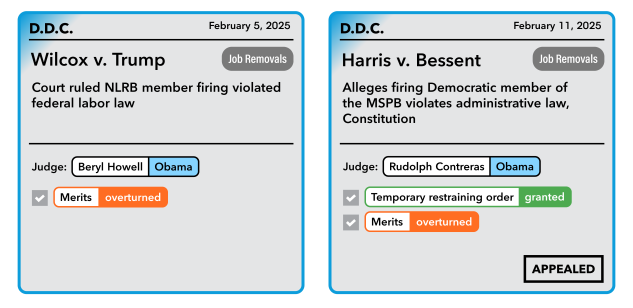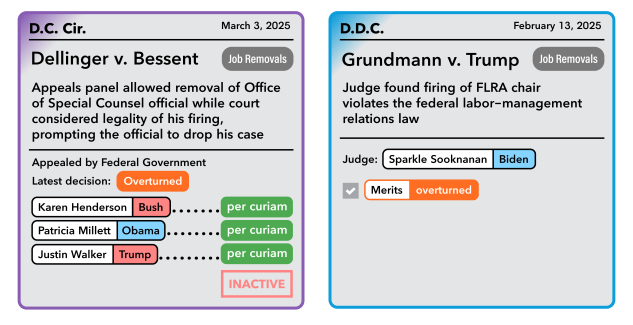- Lawsuits by NLRB, MSPB officials await circuit rulings
- Challenges have potential to reshape presidential power
The lawsuits challenging President Donald Trump’s firing of independent agency officials have moved to the front of the pack of cases likely to be resolved by the US Supreme Court.
Preliminary injunctions have paused many of Trump’s executive actions, but only four suits opposing them have had full consideration at the district court level, according to Bloomberg Law’s analysis of 107 cases. In each, a judge ruled Trump’s dismissal of agency officials was illegal.
The cases brought by National Labor Relations Board member Gwynne Wilcox and Merit Systems Protection Board member Cathy Harris are already before a federal appeals court, giving them the inside track for merits consideration by the Supreme Court.
Their challenges to their firings have moved more swiftly than other cases in part because of their simplicity: They don’t involve factual disputes, require testimony and evidence, requests for preliminary injunctions, or fights over standing or other threshold issues.
“They raise a pure question of the law for courts to entertain,” said Harold Krent, a professor at Chicago-Kent College of Law who authored a book on presidential power.
Trump’s claim that he can fire without cause Senate-confirmed officials who Congress shielded from such at-will termination goes to the heart of his attempt to dominate independent regulatory agencies long insulated from presidential control.
The White House has said that direct presidential supervision and control is necessary for the federal government to be accountable to the public.
The Supreme Court’s consideration of the clash over the firings could set the tone for how the justices will treat his other actions pushing the boundaries of presidential powers.
READ MORE: Tracking Trump in Court: The Scope of Executive Power Tested
‘A Time of Chaos’
The high court in recent years has signaled a willingness to expand the president’s license to fire agency officials with decisions that incrementally weakened their job protections. The court also took a broad view of presidential power in its 2024 Trump v. US decision granting former presidents immunity from some criminal prosecution.
The breakneck pace of actions by the administration and the fallout from them make it difficult to anticipate exactly what’s coming next and when. Trump’s unilateral firing Tuesday night of two Democratic members of the Federal Trade Commission is widely expected to create yet another legal challenge. And other Trump cases could vault ahead of the firing disputes.
“It’s hard to make predictions in times of chaos,” said Eric Segall, a constitutional scholar at Georgia State University and former Justice Department lawyer. “We’re clearly in a time of chaos.”
Other events could give the Supreme Court pause when considering whether to pave the way for White House dominion over the Federal Reserve System, the Securities and Exchange Commission, the Federal Election Commission, and other agencies that have been independent since their creation, legal scholars said.
That includes Trump’s social media call to impeach a federal district judge who ordered his administration to halt deportations of Venezuelan immigrants, an order that appears to have been ignored. That drew a rare public response from Chief Justice John Roberts and signaled such developments could impact the justices’ view of the removal issue, they said.
“The Trump administration has really rubbed their noses in what it means to get rid of independent agencies,” said Daniel Farber, a law professor and faculty co-director of the University of California-Berkeley’s Edly Center on Law & Democracy.
Test Case
Wilcox was among the first ranking officials Trump fired after returning to office, in an email that landed days after his inauguration. Harris was ousted in early Feburary. Both the National Labor Relations Board and the Merit Systems Protection Board serve as watchdogs to protect the rights of private sector and government workers, respectively.
The lawsuits over the removals of the Democratically appointed officials by the Republican president tee up a survival test for the Supreme Court’s 1935 ruling in Humphrey’s Executor v. US, which upheld the constitutionality of for-cause job protections for Federal Trade Commission members, one of whom was fired by President Franklin Delano Roosevelt.
District judges appointed by Democratic presidents cited that 90-year-old precedent when rejecting Trump’s firings of Wilcox and Harris, as well as Susan Grundmann from the Federal Labor Relations Authority and Hampton Dellinger, who led the Office of Special Counsel.
The decision reinstating Dellinger arrived first. But he dropped his case after an appeals court stayed the ruling, saying he faced long odds of prevailing at the Supreme Court.
Dellinger’s case was weaker than those brought by members of agency boards, said Andrea Scoseria Katz, a law professor at Washington University in St. Louis who’s written extensively on presidential power.
In 1988, the high court upheld firing shields for independent counsels based on those officials not interfering with the executive branch’s functions. But it struck down individual agency directors’ job protections in 2020 and 2021 because they wielded executive power in a way that made their offices “illegally mimic the shape of the presidency,” she said.
Humphrey’s 2.0?
The Trump administration has challenged the reinstatement orders for Wilcox and Harris, but hasn’t yet appealed the decision that put Grundmann back to work.
The US Court of Appeals for the District of Columbia Circuit heard oral argument on whether to stay Wilcox and Harris’ district court wins while it considers the administration’s argument for dismissing them. The appeals court’s ruling is pending. The merits of the case are set to be fully briefed in April.
The Supreme Court could end up consolidating the pending firing cases because of their similarities, said Nicholas Bednar, a University of Minnesota law professor who focuses on federal agencies. All three cases feature similar removal shields at adjudicatory agencies that deal with workers’ rights, he said.
But Trump’s firing of two members of the FTC—the very agency at issue in the Humphrey’s Executor decision—creates the opportunity for Supreme Court consideration, Bednar said.
The court could pause the adjudicatory agency cases and hammer out the removal protection issue for FTC members in a “Humphrey’s 2.0,” he said.
There’s also a chance that other Trump-related disputes could leapfrog them, particularly via the emergency docket, legal scholars said. The Supreme Court uses that so-called shadow docket to rule on issues that arise prior to final judgment, such as preliminary injunctions.
A high court ruling on a temporary order wouldn’t be the final word on the underlying legal issue, but it could end the case as a practical matter, said Justin Levitt, a constitutional scholar at Loyola Marymount University who served as a White House advisor on democracy and voting rights during the Biden administration.
That scenario could play out, for example, with a decision refusing to pause the Trump administration’s efforts to dismantle United States Agency for International Development while lower courts weigh the president’s power to unilaterally shut down an agency created by Congress, he said.
“Not only would employees have to move on, some grant recipients would go under,” Levitt said. “That’s not lost on the Supreme Court. The likelihood of emergency docket relief isn’t strong.”
To contact the reporter on this story:
To contact the editors responsible for this story:
Learn more about Bloomberg Law or Log In to keep reading:
See Breaking News in Context
Bloomberg Law provides trusted coverage of current events enhanced with legal analysis.
Already a subscriber?
Log in to keep reading or access research tools and resources.


